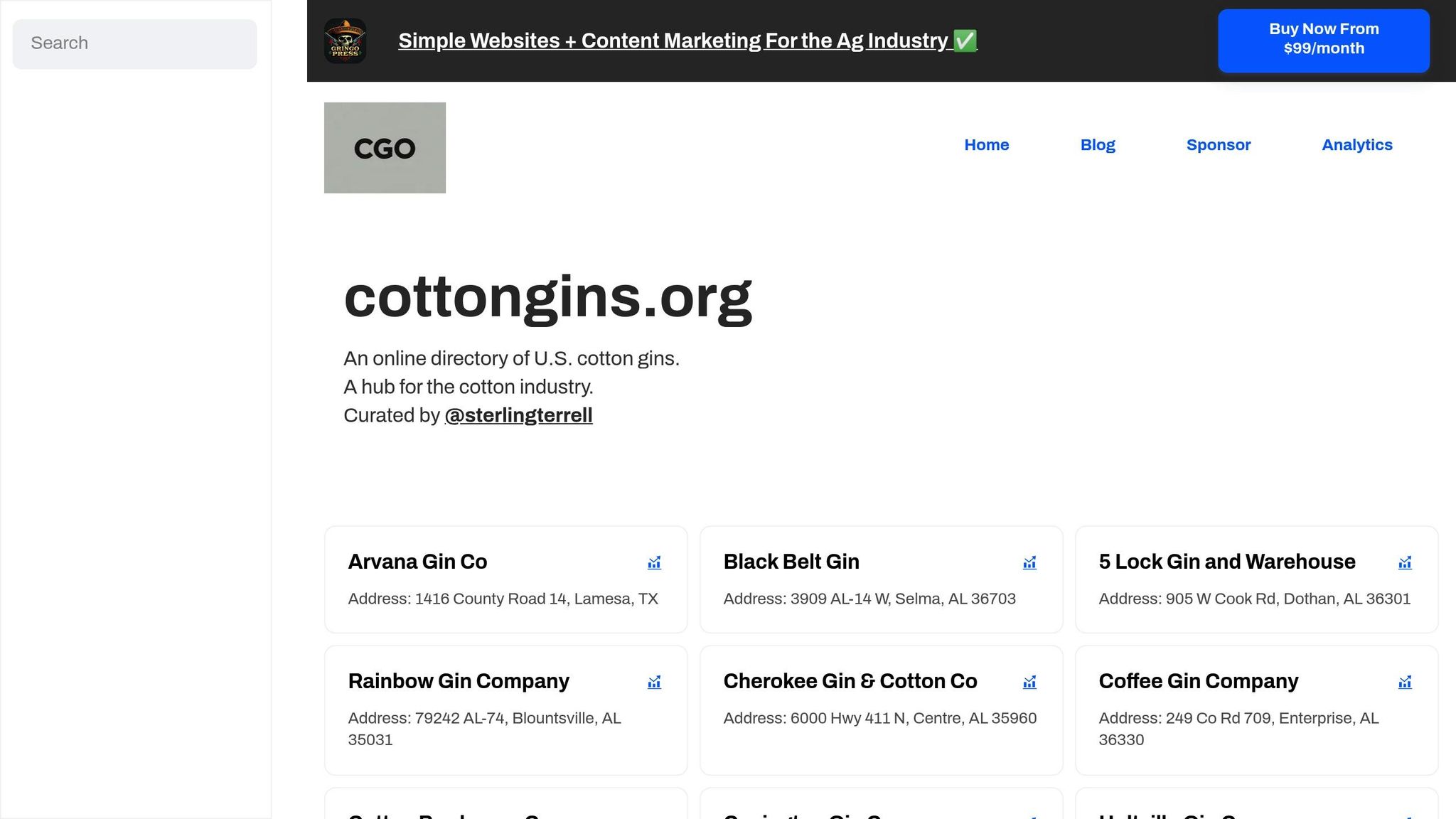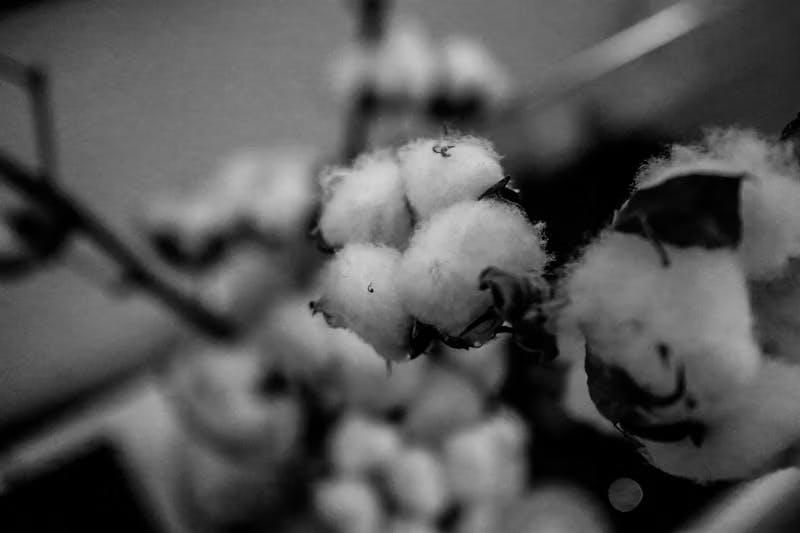Timing your cotton harvest is critical for maximizing yield, fiber quality, and profits. Here’s what you need to know:
- Harvest Timing Basics: Start when 60–75% of bolls have opened. Cotton typically matures 150–180 days after planting.
- State-Specific Timing: In South Texas, harvest begins as early as July. Northern states like Oklahoma and Kansas usually harvest in late September or October.
- Key Influences: Weather, cotton varieties, and farming practices heavily impact timing. For example, delayed harvests risk weather damage, while early harvests may reduce fiber quality.
- Tools and Methods: Use defoliants at the right time (60–75% open bolls) and monitor crop maturity with tools like satellite tracking or boll inspections.
- Local Gins: Coordinate with your cotton gin early to avoid processing delays that can degrade fiber quality.
Quick Tips:
- Optimal Boll Opening: Harvest when 42–81% of bolls are open.
- Weather Considerations: Avoid harvesting in wet or extreme conditions.
- Equipment Choices: Cotton pickers yield cleaner fibers but work slower; strippers are faster but may reduce quality.
Timing is everything. Plan carefully to ensure the best results for your cotton crop.
Cotton Harvest Finale: Your Questions Answered
Factors That Determine Cotton Harvest Timing
Knowing what influences the timing of a cotton harvest is key to maximizing both yield and quality. Three main factors shape when growers decide to harvest: the plant’s natural growth stages, weather conditions, and the specific varieties and farming practices in use.
Cotton Growth Cycle and Maturity
Cotton follows a well-defined growth timeline, typically taking 150–180 days from planting to harvest. The plant progresses through five stages: germination and emergence, seedling establishment, canopy development, flowering and boll formation, and finally, maturation.
Temperature plays a crucial role in this process, measured in DD60s (degree days above 60°F). Cotton needs 2,200 to 2,600 DD60s to reach harvest maturity. This system accounts for temperature fluctuations that can either speed up or slow down growth.
Here’s a breakdown of cotton’s development:
- Emergence: Occurs in 4–9 days, requiring 50–60 DD60s.
- First Square: Takes 27–38 days, needing 425–475 DD60s.
- Flowering: Adds another 20–25 days, requiring 300–350 DD60s.
- Open Bolls: Requires 45–65 days, accumulating 850–950 DD60s.
Each boll takes about 50–60 days to mature, with each containing 32 to 40 seeds. To help manage harvest timing, growers often use satellite monitoring to track boll development and identify areas maturing at different rates. These growth benchmarks provide a foundation for understanding how weather and climate further influence harvest readiness.
Weather and Climate Effects
Weather patterns have a direct impact on cotton maturity and harvest safety. High temperatures during flowering and boll development can reduce yields, while drought conditions may cause flowers to shed prematurely, leading to poor boll formation.
Severe weather events can completely derail harvest plans. For instance, during the 2011 Texas drought, 55% of cotton fields were abandoned, resulting in an estimated $2.2 billion in losses. Events like these highlight the vulnerability of cotton crops to extreme weather.
Climate change is also reshaping cotton production across the U.S. By 2100, projections suggest cotton yields could drop by 30–46% due to rising temperatures, shifting rainfall patterns, and more frequent extreme weather. These changes are forcing growers to rethink their strategies.
"In the face of global climate change, it has become ever more critical to develop cotton varieties that are tolerant to the combination of heat and drought stress." - Michael Gore, Associate Professor of Plant Breeding and Genetics, Cornell University
Excessive rainfall and flooding add another layer of difficulty, damaging root systems, reducing nutrient absorption, and hindering flower and boll growth. Strong winds, hurricanes, and tornadoes can damage plant structures, pushing growers to adjust their schedules. Rising soil salinity, often linked to climate shifts, further slows plant development. These challenges emphasize the importance of selecting the right cotton varieties and employing effective farming practices.
Cotton Varieties and Farm Practices
The type of cotton grown significantly influences harvest timing. For example, American upland cotton, suited to deep, well-irrigated soils, may mature on a different schedule than other varieties.
Farming practices also play a critical role. The use of plant growth regulators (PGRs) can improve uniformity in maturity, which in turn helps with defoliant effectiveness. Timing defoliation is crucial - maximum yields are often achieved when 42% to 81% of the bolls are open, depending on the crop’s maturity and boll distribution.
Defoliation is typically recommended at four nodes above a cracked boll (NACB) for standard populations or three NACB for lower populations, usually after 850 DD60s have been reached.
Harvesting methods also affect timing. Cotton pickers are more selective, producing cleaner, higher-quality lint, but they work slower and cost more. On the other hand, cotton strippers are faster and cheaper but collect all material, which can lower fiber quality. To optimize harvest timing, growers monitor crop maturity, field conditions, and environmental factors. Early fiber samples are often tested for micronaire, strength, and color to determine the best time to harvest.
Cotton Harvest Timing by State
Understanding when to harvest cotton at the state level is vital for farmers aiming to optimize both yield and quality. The timing varies widely due to differences in climate, growing seasons, and farming practices across regions.
Harvest Dates for Each State
Cotton harvest kicks off in South Texas as early as July and gradually moves northward, wrapping up in October. States like Texas and Georgia, with their warmer climates and extended growing seasons, typically harvest between August and September. In the Mid-South - covering Arkansas, Mississippi, and Louisiana - the harvest window generally falls between September and October. Meanwhile, western states like Arizona and California often begin harvesting in October, sometimes stretching into November.
Take 2022 as an example: Louisiana had completed its harvest by mid-November, while Arizona lagged, with only 53% of its crop harvested. Equipment preferences also differ by region - Texas and Oklahoma primarily use stripper harvesters, while spindle pickers dominate in other parts of the Cotton Belt. During one notable week in November 2022, Oklahoma’s harvest jumped by 16 percentage points, Kansas by 14, and states like Alabama, California, Georgia, North Carolina, and Texas each saw a 10-point increase.
By November 2022, 71% of the U.S. cotton crop had been harvested - 8 percentage points ahead of the five-year average. These trends underscore how state-level conditions influence harvest timing across the country.
Regional Differences Within States
Even within a single state, harvest timing can vary significantly due to factors like microclimates, soil types, and elevation. Warmer areas tend to harvest earlier, as higher temperatures can shorten the cotton-growing period. Elevation and proximity to water bodies can also create subtle differences in harvest timing.
Rainfall plays a big role too. Regions with heavier rains might face delays, even if planting dates were the same. Well-drained soils can recover faster after rain, allowing for earlier harvests, while heavier soils often need more time to dry.
Temperature trends add another layer of complexity. Studies show that the number of days with temperatures above 50°F has been increasing by 5.2 days per decade. However, this shift doesn’t occur uniformly, leading to varied growing conditions across regions.
Farmers have adapted to these challenges by staggering planting dates across different fields. This strategy helps spread out the workload and ensures harvest operations align with the readiness of each field.
"Earlier is always better to harvest, in my opinion. Typically, the later you are harvesting the higher the risk of delays from wet weather, which means loss of lint and fiber quality."
– Brian Pieralisi, Mississippi State University assistant professor and Extension cotton specialist
These regional differences highlight the importance of monitoring local conditions. Relying solely on state-level guidelines can lead to missed opportunities or risks. By tailoring their approach - such as timing defoliant applications and scheduling harvests - farmers can better manage their operations and protect crop quality.
sbb-itb-0e617ca
How Harvest Timing Affects Cotton Quality and Yield
Nailing the right timing for defoliation is a game-changer when it comes to cotton farming. It’s the difference between a profitable season and one that falls short. By understanding how harvest timing impacts fiber quality and yield, growers can make smarter decisions for their crops.
Getting the Best Fiber Quality and Yield
The ideal window for cotton harvest typically lies between 42% and 81% of open bolls, depending on factors like crop maturity and boll distribution. This range gives farmers some flexibility but also demands close monitoring to hit the sweet spot for their specific conditions.
Fiber quality is at its best when defoliation happens at just the right moment. Waiting too long can hurt key factors like fiber length, strength, and color - all of which directly affect lint loan values and overall profitability. To safeguard fiber integrity, defoliants should be applied about 10–14 days before harvest.
There are three tried-and-true methods to determine the right timing for defoliation:
- Percent Open Boll: Start when around 60% of the bolls in the field have opened.
- Nodes Above Cracked Boll: Defoliate when there are no more than four nodes above the uppermost first-position cracked boll.
- Sharp Knife Method: Cut open bolls from the top two nodes. If the seeds have a well-defined, darker seed coat, it’s time to act.
Staggering defoliation across different fields is another smart strategy. It spreads out the harvest schedule, minimizing the risk of having all your cotton ripen at once and leaving some crops exposed to potential damage.
"Earlier is always better to harvest, in my opinion. Typically, the later you are harvesting the higher the risk of delays from wet weather, which means loss of lint and fiber quality." – Brian Pieralisi, Mississippi State University assistant professor and Extension cotton specialist
The best harvest conditions include several days of warm, sunny weather. This ensures that bolls are dry enough to snap off easily and reduces the risk of moisture-related quality issues.
On the flip side, mistimed harvests can significantly hurt both fiber quality and overall yield.
Problems with Wrong Harvest Timing
Harvest timing mistakes can lead to costly consequences, whether you’re too early or too late. Defoliating before bolls are fully mature stops fiber development prematurely, reducing both yield and quality. Similarly, using boll openers too soon can lower micronaire readings and shorten fiber length, which translates to lower gin prices and reduced profitability.
Delaying harvest comes with its own set of challenges. According to Bayer's Crop Science division, leaving cotton in the field too long "can compromise the quality and potential yield of a cotton crop". Mature cotton left exposed is at greater risk for weather damage, insect feeding, and natural fiber degradation.
Regions prone to wet weather face even more risks with delayed harvests. Rain can stain fibers, lower grades, and make mechanical harvesting more difficult. Each day of delay increases the likelihood of these setbacks, leading to reduced fiber quality and lower returns.
Late harvesting also accelerates fiber deterioration, including losses in length, strength, and color. This not only lowers lint value but also makes the cotton more likely to face market discounts.
Beyond the current season, poor timing can impact preparations for the next crop. A timely harvest allows for better decomposition of plant residue and stalks, which helps manage pests and diseases that could carry over to the following year.
Choosing the right harvest aids and timing based on experience, market trends, and environmental conditions is crucial. It protects your current investment and sets the stage for a stronger start in the next growing season.
Working with Local Cotton Gins
Timing your harvest to align with your local cotton gin’s schedule is crucial for efficient processing. These modern facilities are built for speed, capable of handling up to 33,000 pounds of cotton per hour and processing as many as 1,500 bales daily.
To make this process smoother, limit your harvest aid treatments to only the acreage you can realistically harvest within 7 to 12 days. Treating too much at once can lead to lower yields, increased weather exposure, and unwanted regrowth.
Before you start harvesting, reach out to your gin to secure a spot on their schedule. Delays in ginning can result in serious consequences, like microbial growth, fiber quality loss, and reduced market prices. Communicating early also gives the gin time to prepare for any specific needs or issues.
When planning your harvest, make sure your fields are ready to go when the gin is available. This is especially critical during peak season when many farms are competing for processing time.
It’s also worth noting that cotton harvested by different methods contains varying levels of foreign material. For example, hand-harvested cotton typically has 1–5% foreign matter, while stripper-harvested cotton can contain as much as 10–30%. Understanding these differences can help you and your gin optimize the processing workflow. If you need extra help coordinating with your gin, online tools can be a game-changer.
Using cottongins.org to Find Cotton Gins

Online resources like cottongins.org make finding the right cotton gin easier than ever. This directory lists U.S. cotton gins by state and county, helping you locate facilities close to your farm. Shorter transport distances not only cut down on costs but also help maintain cotton quality during transit.
The directory provides detailed addresses for gins, allowing you to compare options based on proximity. It also lets farmers submit new gin entries to ensure the database stays up-to-date. Additionally, gins can increase their visibility through sponsorship options like sponsored posts and featured listings.
Using cottongins.org can also help you identify backup gins in case your primary facility faces capacity or equipment issues. Having alternatives lined up is a smart way to protect your cotton’s quality and your bottom line.
Cotton Harvest Timing: Main Points to Remember
Here’s a quick rundown of the crucial steps to keep in mind for timing your cotton harvest effectively.
The cotton plant's lifecycle typically lasts between 150–180 days. Harvest should begin when approximately 60% of the bolls have opened. This timing ensures you’re capturing the best balance between yield and quality.
To get an accurate read on your field, assess at least 20 plants. When 60–75% of the bolls have opened, apply defoliants during dry and warm weather. Begin harvesting once the moisture level drops to around 12%.
Make sure your equipment is ready to go. Clean and calibrate your machinery, and test early fiber samples for factors like micronaire, strength, and color. These steps ensure your harvest maintains high-quality standards.
Avoid harvesting under poor weather conditions like heavy humidity, frost, or extreme dryness. Picking too early can lead to immature fibers, while waiting too long risks degrading the lint quality.
The type of harvesting equipment you choose makes a difference. Cotton pickers produce cleaner, higher-quality lint, but work slower. On the other hand, strippers are faster but may compromise fiber quality. Decide based on whether speed or quality is your top priority.
Lastly, plan ahead with your local cotton gin. Visit cottongins.org to locate nearby facilities and arrange backup options to avoid any last-minute issues. Early coordination can save you a lot of headaches down the line.
FAQs
How does weather impact the timing and quality of a cotton harvest?
Weather significantly influences the timing of cotton harvesting and the quality of the crop. Too much rain can delay the harvest, stain the lint, and weaken the fibers, which lowers the crop's grade and market value. On the flip side, extreme heat and drought can interfere with boll opening and fiber growth, reducing both yield and fiber strength.
The ideal scenario for cotton production is stable weather with mild temperatures and limited rainfall. These conditions help the cotton mature correctly, leading to a well-timed harvest and higher-quality fibers.
What are the pros and cons of using cotton pickers versus cotton strippers for harvesting?
When it comes to harvesting cotton, cotton pickers and cotton strippers each bring their own set of strengths and limitations, and the right choice largely depends on your specific needs.
Cotton pickers are known for their precision and gentleness. They carefully harvest only the ripe bolls, which helps maintain higher fiber quality and minimizes damage to the cotton. The trade-off? These machines can be pricier to run and require more maintenance.
On the flip side, cotton strippers are a more budget-friendly option and excel in large-scale operations. They remove all the bolls, making them especially effective in challenging weather or when crops in the field mature unevenly. However, this less selective approach can result in more fiber damage and a dip in cotton quality.
The decision ultimately hinges on factors like the size of your field, the condition of your crops, and the quality standards you're aiming to meet.
What are the best ways for farmers to coordinate with local cotton gins for timely harvest processing?
To make sure your cotton harvest gets processed on time, it’s crucial to schedule with your local cotton gins early. Keeping an open line of communication with gin operators helps match your harvest schedule with their processing capacity. Once harvesting is complete, quickly transporting cotton modules and staying informed about the gin’s availability can help you avoid unnecessary delays.
You can also use tools like RFID technology or other logistics solutions to simplify tracking and managing your cotton. Regularly touching base with your gin operator ensures the process runs smoothly and helps preserve the quality of your cotton during processing.


